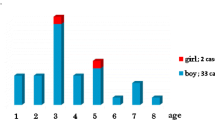Abstract
Purpose
This study aimed to present a 16-year experience of treating sagittal synostosis with endoscopic-assisted techniques and postoperative cranial orthotic therapy. In 1996, we introduced the use of endoscopes for the management of sagittal synostosis in four young infants. During the subsequent years, we have treated a total of 256 patients with great success and long-term follow-up. Presented herein are the techniques and results of such clinical experience.
Methods
A total of 256 patients with sagittal synostosis have been treated between May 1996 and April 2012. There were 187 males and 69 females. Mean age at time of surgery was 3.9 months. A wide-vertex craniectomy with bilateral barrel stave osteotomies of the temporal and parietal bones using small scalp incisions and endoscopic viewing techniques was performed. Instruments have been developed to assist with the operation. All patients were placed in postoperative molding cranial orthosis.
Results
Mean estimated blood loss was 27 cc. Mean transfusion rate was 7 %. Mean surgical time was 57 min. Mean length of stay was 1.1 days. Using cephalic index (CI) as an anthropometric measurement to judge head shape, our results were classified as excellent (CI > 80), good (CI 80–70), or poor (CI < 70). A total of 87 % were classified as excellent, 9 % as good, and 4 % as poor.
Conclusions
Endoscopic-assisted management of sagittal synostosis is a safe, efficacious, and excellent option for treating this condition with long-lasting, superb results. It is associated with minimal morbidity and complications and improved results over traditional procedures.










Similar content being viewed by others
References
Amm CA, Denny AD (2005) Correction of sagittal synostosis using foreshortening and lateral expansion of the cranium activated by gravity: surgical technique and postoperative evolution. Plast Reconstr Surg 116:723–735
Boop FA, Chadduck WM, Shewmake K, Teo C (1996) Outcome analysis of 85 patients undergoing the pi procedure for correction of sagittal synostosis. J Neurosurg 85:50–55
Greene CS Jr, Winston KR (1988) Treatment of scaphocephaly with sagittal craniectomy and biparietal morcellation. Neurosurgery 23:196–202
Jane JA, Edgerton MT, Futrell JW, Park TS (1978) Immediate correction of sagittal synostosis. J Neurosurg 49:705–710
Jimenez DF, Barone CM (2000) Endoscopy-assisted wide-vertex craniectomy, “barrel-stave” osteotomies, and postoperative helmet molding therapy in the early management of sagittal suture craniosynostosis. Neurosurg Focus 9(3):e2, www.neurosurgery.org/focus/sep00/9_3_nsf_toc.html
Jimenez DF, Barone CM, Cartwright C, Baker L (2002) Early management of craniosynostosis using endoscopic assisted strip craniectomies and cranial orthotic molding therapy. Pediatrics 110:97–104
Jimenez DF, Barone CM, McGee ME, Cartwright CC, Baker CL (2004) Endoscopy-assisted wide-vertex craniectomy, barrel stave osteotomies, and postoperative helmet molding therapy in the management of sagittal suture craniosynostosis. J Neurosurg (Pediatrics 5) 100:407–417
Komuro Y, Ynai A, Hayashi A, Nakanishi H, Miyajima M, Arai H (2005) Cranial reshaping employing distraction and contraction in the treatment of sagittal synostosis. Br J Plast Surg 58:196–201
Marchac D, Renier D, Broumand S (1994) Timing of treatment of craniosynostosis and faciocraniosynostosis: a 20 year experience. Br J Plast Surg 47:211–222
Renier D, Lajeunie E, Arnaud E, Marchac D (2000) Management of craniosynostosis. Childs Nerv Syst 16:645–658
Shillito J (1992) A plea for early operation for craniosynostosis. Surg Neurol 37:182–187
Shillito J, Matson DD (1968) Craniosynostosis: a review of 519 surgical patients. Pediatrics 41:829
Tullous MW, Henry MN, Wang PTH, Vollmer DG, Auber AE, Mancuso PA (2001) Multiple-revolution spiral osteotomy for cranial reconstruction. J Neurosurg 94:671–678
Volmer DG, Jane JA, Park TS, Persing JA (1984) Varients of sagittal synostosis: strategies for surgical correction. J of Neurosurg 61:557–562
Author information
Authors and Affiliations
Corresponding author
Rights and permissions
About this article
Cite this article
Jimenez, D.F., Barone, C.M. Endoscopic technique for sagittal synostosis. Childs Nerv Syst 28, 1333–1339 (2012). https://doi.org/10.1007/s00381-012-1768-y
Received:
Accepted:
Published:
Issue Date:
DOI: https://doi.org/10.1007/s00381-012-1768-y




